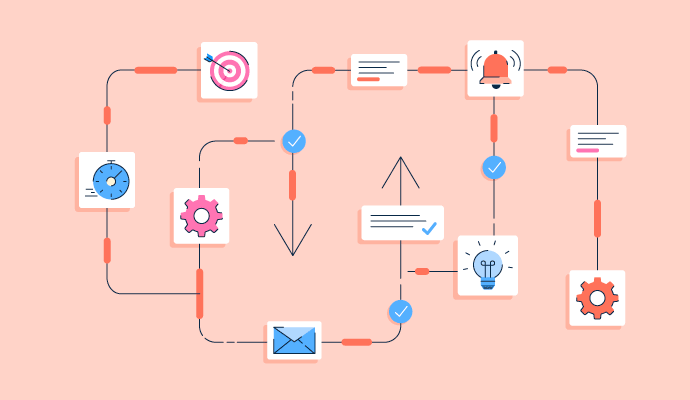Are you feeling overwhelmed by the number of projects you're juggling? Like you're constantly trying to keep track of multiple projects, all with different deadlines and stakeholders? If so, you're not alone.
This is where program management can help you out.
Program management is about understanding the big picture, communicating effectively, identifying risks, and mitigating problems before they happen. And it's about using the right tools and techniques to get the job done.
One of the tools that program managers swear by is program management software. It automates several tasks, such as scheduling, budgeting, and communication, while tracking progress and identifying potential problems early on. This frees up your time to focus on the program's more strategic aspects and deliver complex projects on time, within budget, and to the required quality standards.
What is program management?
Program management is the process of coordinating and managing multiple projects to successfully deliver complex initiatives. It involves defining the program scope and objectives, developing a plan, managing the budget and resources, communicating with stakeholders, and ensuring the program's success.
In this article, we'll examine what program management is and why it's important. We'll also discuss some key skills and tools you need to be a successful program manager.
So whether you're feeling overwhelmed by your workload or just interested in learning more about this domain, read on for some helpful insights.
Program management vs. project management
Project management and program management are closely related disciplines essential for achieving organizational goals. However, there are a few notable differences between the two fields.
Project management is the process of planning, organizing, and managing resources to achieve a specific goal. Projects are typically temporary, with a defined start and end date.
Program management is the process of overseeing and coordinating multiple projects to achieve a common goal. Programs are typically more elaborate than projects and may involve multiple teams, departments, or organizations.
Below are some of the key differences between project management and program management.
- Scope: Projects typically have a single, well-defined scope. Programs, on the other hand, may have multiple projects with overlapping or interrelated scopes. For example, a program to develop a new product might include projects for research and development, manufacturing, and marketing.
- Duration: Projects are typically temporary, with a defined duration. On the other hand, programs may be long-term, with no set end date. A program to implement a new customer relationship management (CRM) system might take several months to complete.
- Goals: Project goals are specific, measurable, achievable, relevant, and time-bound. Program goals are typically broader and more strategic. A project goal might be to launch a new product by a specific date, whereas a program goal might be to increase customer satisfaction by 10% over the next year.
- Resources: Projects typically require a team, budget, and time. On the other hand, programs run multiple projects and require coordination between them. For example, a program to develop a new product might require a team of engineers, a budget of $10 million, and two years to complete.
- Manager: Project managers ensure that projects are completed on time, within budget, and to the required quality standards. Program managers are responsible for ensuring that the overall program is successful and that the individual projects within the program are aligned with its goals.
Program management vs. product management
The following table summarizes the key differences between program management and product management:
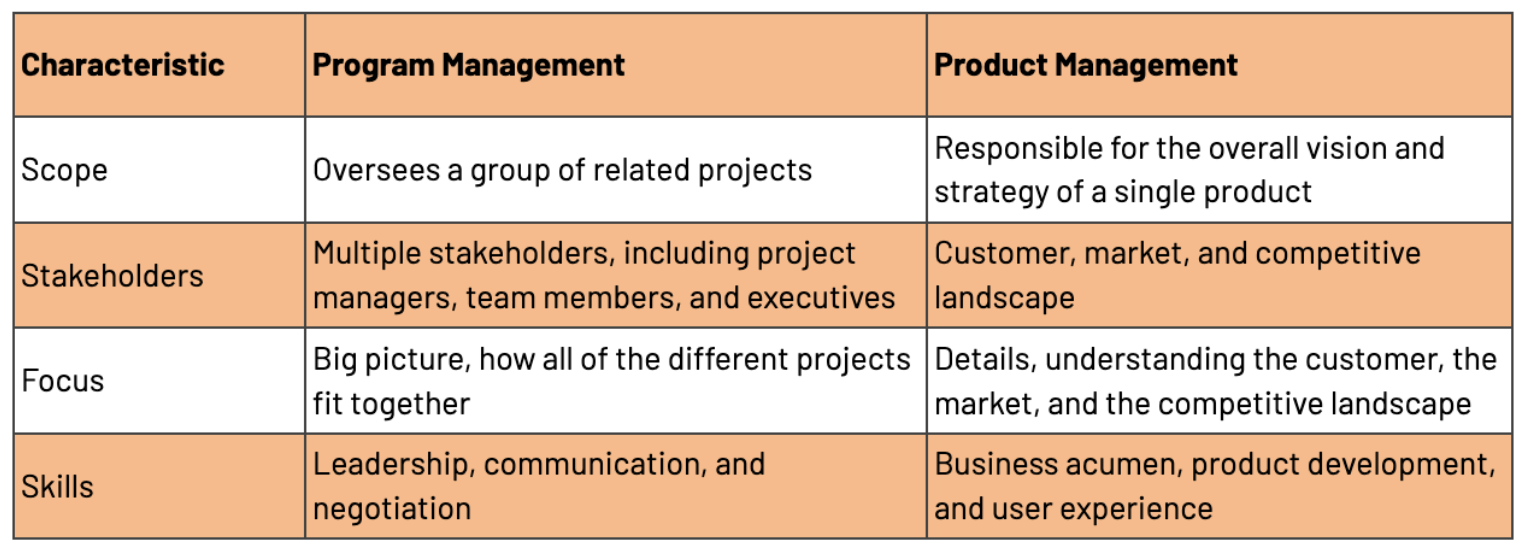
Want to learn more about Project Management Software? Explore Project Management products.
Program lifecycle
The program lifecycle is the process that a program goes through from start to finish. The entire process is dynamic, and you may need to go back and revisit previous phases if necessary.
For example, if new requirements or market trends like incorporating augmented reality (AR) emerge during the development of a mobile application, the team may need to go back to the initiation phase to revise aspects like the program’s scope, budget, and timeline.
- During initiation, you define the program's goals and objectives, identify the key stakeholders and projects that will be included, and develop a plan for executing the program.
- Planning is where you get down to the nitty-gritty and develop more detailed plans for each project in the program. This includes identifying the resources that will be needed, developing schedules and budgets, and defining the roles and responsibilities of the team members. You must ensure that all projects align with the program's goals and objectives and are feasible within the given timeframe and budget.
- With your roadmap in hand, it's time to embark on the execution phase. This is where the real work happens, where you put your plans into action. You coordinate and manage multiple projects, monitor progress, and ensure that tasks are completed on time and within budget. Collaboration and effective communication play a pivotal role in this phase.
- The monitoring and control phase ensures that the program is aligned with the intended outcomes and allows for proactive decision-making. You track key performance indicators, identify and mitigate risks, and make necessary adjustments to stay on track.
- Closing is where you wrap up the program and celebrate the achievements. Conducting project reviews, capturing lessons learned, and documenting best practices for future programs are a part of the final phase of the program lifecycle. It also includes transitioning deliverables to stakeholders, evaluating the program's success, and acknowledging the team's efforts.
Managing the program lifecycle effectively ensures that you have a structured approach to achieving your program's goals, overcoming challenges, and delivering successful outcomes.
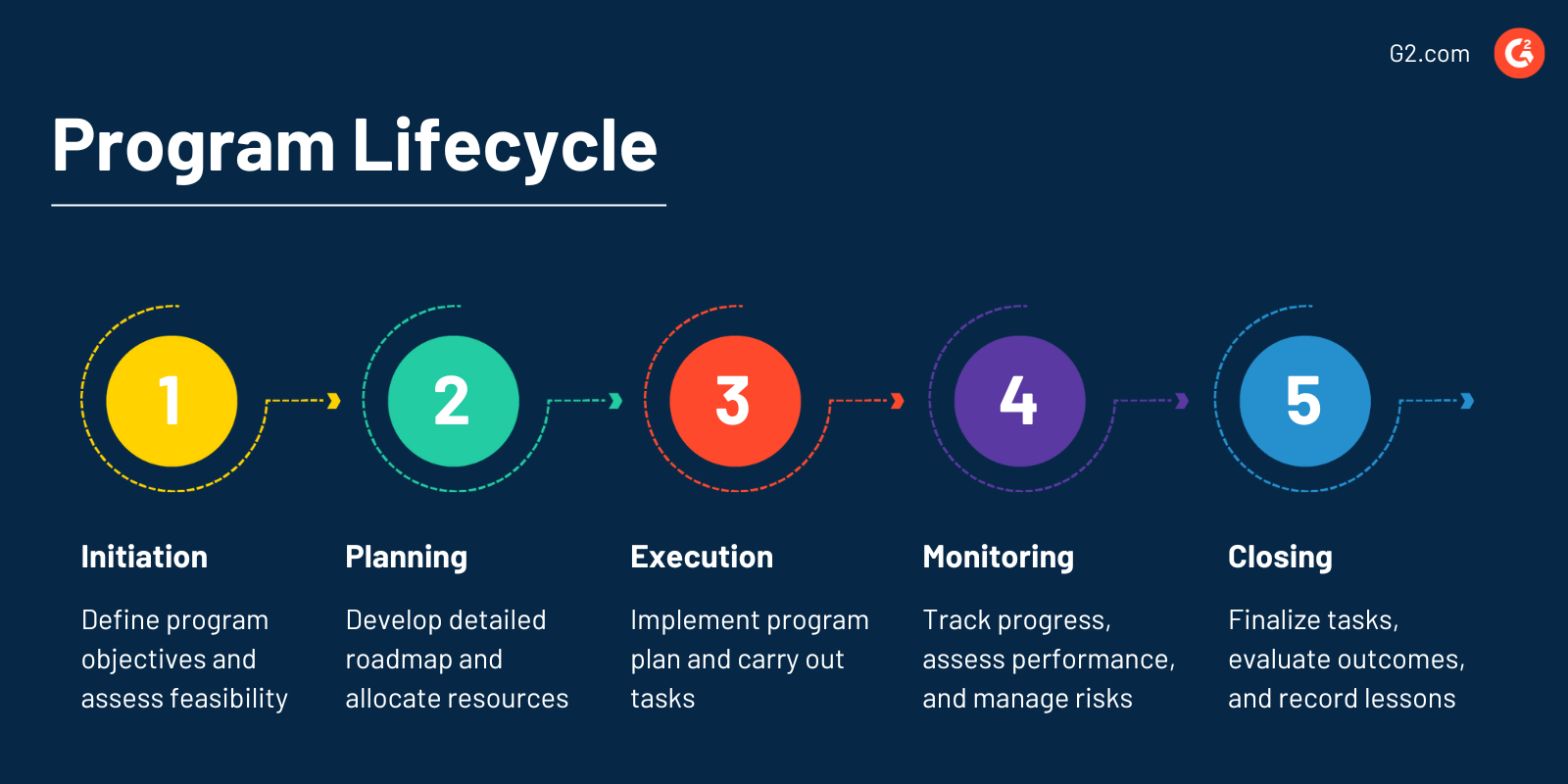
Program management examples
In today's bustling business environment, it's more important than ever to have a robust program management process in place. It provides a systematic approach to strategic planning, organizing, and managing project resources. Various organizations, from large enterprises to government agencies to non-profit organizations, benefit from proper planning and execution.
Here are some examples of how program management can be used in different scenarios.
- Enterprise-wide software implementation. When a large organization plans to implement a new software system across multiple departments, program management ensures that the implementation is seamlessly coordinated and meets all needs.
- Infrastructure development. If we were to take the example of a project to build a new light rail system, the program would involve multiple teams, such as engineering, construction, and procurement. Program management ensures that all the project teams work together effectively to complete the construction time and within budget.
- Product launch. When a company prepares to launch a new product or service, program management guarantees that the launch is coordinated seamlessly across marketing, product development, sales, and customer support.
- Organizational change initiatives. For an organization undergoing significant change, such as a merger, acquisition, or restructuring, program management manages stakeholder engagement, drives effective communication, eases cultural changes, and handles employee training.
Program management key performance indicators (KPIs)
- Cost and performance earned value
- Return on investment (ROI) for the program
- Customer engagement, satisfaction, and retention
- Team performance
- Project completion rate
Read more about KPIs for program management for different industries.
What is a program manager?
A program manager is responsible for the planning, execution, and delivery of complex projects. They work with various stakeholders and are responsible for bringing together a program's different elements. As a program manager, you must ensure that the program meets its objectives and stays on track.
You must see the big picture and understand how individual projects fit into the program. The specific responsibilities will vary depending on the organization and the program.
However, some typical program manager duties are:
- Defining the program scope and objectives.
- Developing a program plan.
- Managing the program budget.
- Monitoring and reporting on program progress.
- Resolving issues and risks.
- Communicating with stakeholders.
Program management skills
- Communication: It is crucial to have the ability to communicate effectively with a variety of stakeholders, including project managers, team members, and senior management, to clearly explain the program's goals, objectives, and progress.
- Leadership: Leading and motivating team members, setting clear goals and expectations, and resolving conflicts are necessary skills.
- Problem-solving: Identifying and solving problems, thinking critically and creatively, and making decisions under pressure comes under the bucket of problem-solving skills.
- Project management: Understanding project management principles and practices translates to successful program management.
Benefits of program management
Program management offers many benefits beyond simply reducing the workload of program managers. It provides a comprehensive, structured approach to managing multiple related projects and sets you up for success by preparing you to respond effectively to the changing business environment.
- Strategic alignment. Program management ensures that projects within a program are aligned with the organization's strategic goals. It helps maintain focus on making sure that all program activities contribute to the desired outcomes.
- Efficient resource utilization. A well-made framework for controlling resources shortens project timelines, lower costs, and presents higher-quality deliverables. Optimized allocation of budget, personnel, and other resources, maximizes utilization, and minimizes waste.
- Coordination and integration. The alignment between different projects aids in the smooth flow of information, resources, and dependencies between different teams. It ensures seamless workflow, avoiding redundancies, conflicts, and inefficiencies.
- Risk management. Program management takes a holistic view of program-level risks. It enables identifying, assessing, and mitigating risks across various projects, minimizing negative impacts on the overall program.
- Organizational learning. Capturing lessons learned from individual projects helps identify best practices, improvement areas, and knowledge-sharing opportunities. This enhances the organization's project management capabilities and fosters continuous improvement.
- Stakeholder engagement. Program management emphasizes stakeholder engagement and communication. It involves identifying and prioritizing stakeholders, managing their expectations, and ensuring effective communication throughout the program. This enables stakeholders to stay informed, aligned, and engaged in program activities.
Program management challenges
While program management brings numerous benefits, you might encounter challenges managing resources, risk, and changing requirements. Here are some common challenges people face regardless of their industry.
- Scope creep is the tendency for projects to grow in scope over time as program stakeholders provide input and new requirements emerge. This can be a significant challenge, leading to budget overruns, schedule delays, and project failure. Managing scope changes and ensuring they align with the program's objectives and resources can be challenging.
- Resource allocation with limited resources, such as budget, personnel, and equipment, can be tricky. You must pay special attention to the distribution to ensure the successful execution of all projects within the program.
- Project interdependencies are expected in a program, where the progress of one project affects others. Managing these interdependencies, coordinating efforts, and resolving conflicts or bottlenecks can be challenging.
- Risk management can be complex, as it requires assessing the likelihood and impact of risks and developing and implementing plans to mitigate them.
- Managing stakeholders with differing expectations, keeping them informed, and ensuring effective communication channels can be challenging because it requires the ability to tailor communication to different audiences.
- Change management strategies are crucial to resistance management and smooth transition since programs often involve significant changes to processes, systems, and organizational structures.
Despite the challenges, overcoming them can lead to successful program outcomes and the realization of benefits for the organization.
Overcoming the challenges
By implementing these strategies, you can overcome common challenges and steer the program toward successful outcomes.
- Proactively manage scope. Clearly define the scope of each project, set expectations, and regularly review and refine requirements.
- Foster effective communication. Encourage open and transparent communication, conduct regular program meetings, and provide regular project status updates.
- Implement risk management strategies. Develop a comprehensive risk management plan, identify potential risks, assess their impact, and develop mitigation strategies.
- Engage stakeholders effectively. This is through regular communication, workshops, and feedback sessions.
- Monitor and adapt. Regularly monitor the program's progress, track progress against determined metrics, and conduct performance assessments.
Program management templates
Program management templates provide a framework for defining the program, identifying stakeholders, managing risks, and communicating with stakeholders.
Program managers of all levels of experience can use these templates. For new managers, it provides a roadmap for managing a program, and for experienced program managers, a way to ensure that they follow best practices.
The templates you use will depend on the size and complexity of your program, as well as your organization's specific needs. Linked below are 14 free program management templates by Smartsheet that you can use as a starting point.
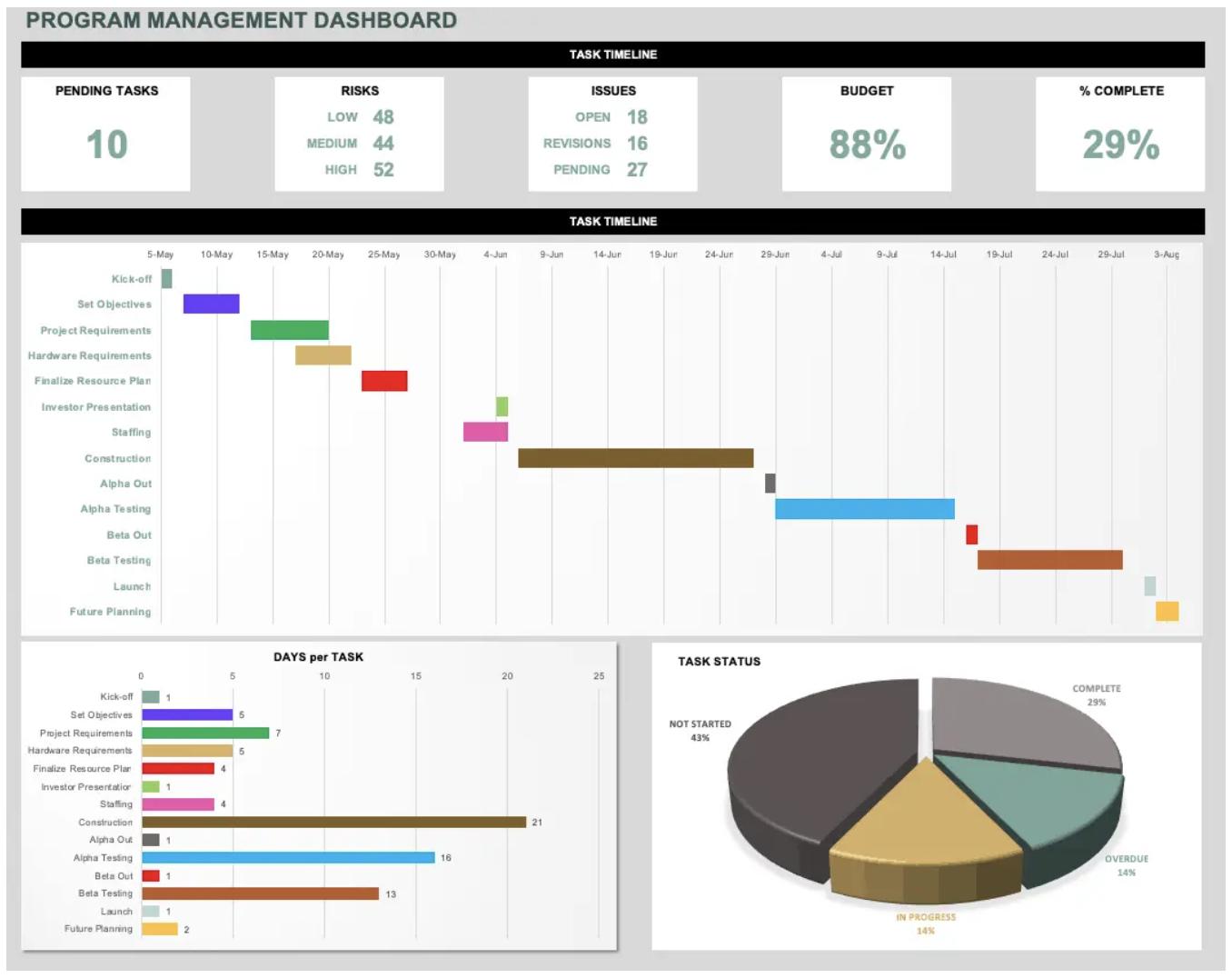 Source: Smartsheet
Source: Smartsheet
Program management best practices
Program management is a complex and challenging field, but by following certain best practices, you can improve the chances of your success. These best practices provide a foundation; however, they should be tailored and customized to meet your organization and program's specific needs and context.
- Establish strong program governance. Implement a governance framework that provides clear roles, responsibilities, and decision-making authority. To ensure effective oversight and control, define governance processes, such as regular program reviews, steering committee meetings, and escalation procedures.
- Use a program management methodology. Several program management methodologies are available, such as projects in a controlled environment (PRINCE2), project management body of knowledge (PMBOK), and Agile. Choosing the suitable methodology will depend on the size and complexity of the program, as well as the specific needs of the organization.
- Develop a robust program plan. Create a comprehensive program plan with a clear roadmap, identified deliverables, timelines, milestones, and resource allocation. Regularly review and update the plan to address changes or new requirements.
- Engage stakeholders actively. Engage key stakeholders early and continuously throughout the program. Involve them in decision-making processes, seek their input, and communicate program progress, milestones, and challenges. Address their concerns and gain their buy-in to ensure their commitment to the program's success.
- Adapt to dynamic environments. Recognize that programs operate in dynamic and evolving environments. Remain flexible and adaptive to changes in project requirements, market conditions, and organizational priorities. Continuously assess the program strategy and adjust plans to ensure alignment with evolving needs.
- Continuous improvement. Foster a culture of continuous improvement within the program. Regularly evaluate program performance, learn from successes and failures, and identify areas for enhancement. Encourage feedback, retrospectives, and lessons learned sessions to drive ongoing program improvement.
- Use program management software. There are a variety of project management tools available that can help program managers to plan, track, and manage their programs.
- Celebrate successes. Last but not least, it's important to celebrate successes along the way. This will help to keep morale high and to motivate the team.
Program management tools
Program management tools are software applications that can help program managers to plan, track, and manage their programs. They are a valuable asset for program managers, as they can help to save time and effort, improve communication, and increase visibility and transparency.
Various program management tools are available, from simple tools to more complex enterprise resource planning (ERP) systems. The specific tools used will vary depending on the size and complexity of the program, the resources available, and the experience of the program manager.
Some of the most common features of program management tools include:
- Project planning: Create project plans, track project progress, and identify and manage risks.
- Resource management: Track the allocation of resources, identify and manage conflicts, and ensure that projects are completed on time and within budget.
- Communication: Share information and collaborate on projects.
- Reporting: Generate reports on project progress, risks, and costs.
- Dashboards: A visual overview of project progress, risks, and expenses.
Multiple tools come under the greater realm of program management software. G2 hosts several categories under program management, including, but not limited to:
Capital project management software
Capital management software helps manage capital investments and financial resources. In the context of program management, capital management software enables program managers to track project costs, analyze financial performance, allocate funds to individual projects, and make informed decisions regarding resource allocation.
It plays a crucial role in optimizing the utilization of financial resources, aligning financial objectives with program goals, and enhancing the overall financial performance of programs. It can be used standalone or as a part of other program management software.
Top 5 capital project management software
*These are the leading capital project software solutions from G2’s Summer 2023 Grid® Report.
Kanban project management software
Kanban project management software facilitates the implementation of the Kanban method for project management. Kanban is an agile approach that visualizes work using a kanban board, where tasks are represented as cards that move across columns to indicate their progress.
Program managers can use kanban software to visualize the program's workflow, allocate resources, monitor project status, and ensure smooth coordination among different projects within the program. By utilizing kanban project management software, program managers can gain greater visibility into the program's progress, identify bottlenecks, and optimize resource allocation, resulting in improved program performance and successful delivery of program objectives.
Top 5 kanban project management software
*These are the leading kanban project management software solutions from G2’s Summer 2023 Grid® Report.
Project management software
Project management software is designed to assist in planning, organizing, and overseeing the execution of projects. It provides functionalities like task management, scheduling, resource allocation, collaboration, and progress tracking. It supports the management of multiple projects within a program. This software enables program managers to streamline project management processes, improve coordination, and successfully deliver program goals and objectives.
Top 5 project management software
*These are the leading project management software solutions from G2’s Summer 2023 Grid® Report.
Resource management software
Resource management software helps organizations plan, allocate, and optimize resources such as people, equipment, and materials across projects and programs. By using this software, program managers can balance workloads, prevent resource conflicts, ensuring the optimal utilization of resources throughout the program. It ultimately supports you in achieving program objectives by maximizing resource productivity, minimizing bottlenecks, and maintaining a strategic alignment between resource availability and project demands.
Top 5 resource management software
- Kantata Cloud for Professional Services (formerly Mavenlink + Kimble)
- Float
- ClickTime
- Resource Guru
- LiquidPlanner
*These are the leading resource management software solutions from G2’s Summer 2023 Grid® Report.
Work management software
Work management software simplifies and optimizes the management of tasks, projects, and workflows. It provides task tracking, collaboration, document sharing, scheduling, and reporting features. It helps program managers oversee the execution of various projects within a program. You can create and assign tasks, track project progress, monitor deadlines, collaborate with teams, and assess overall program performance.
Top 5 work management software
*These are the leading work management software solutions from G2’s Summer 2023 Grid® Report.
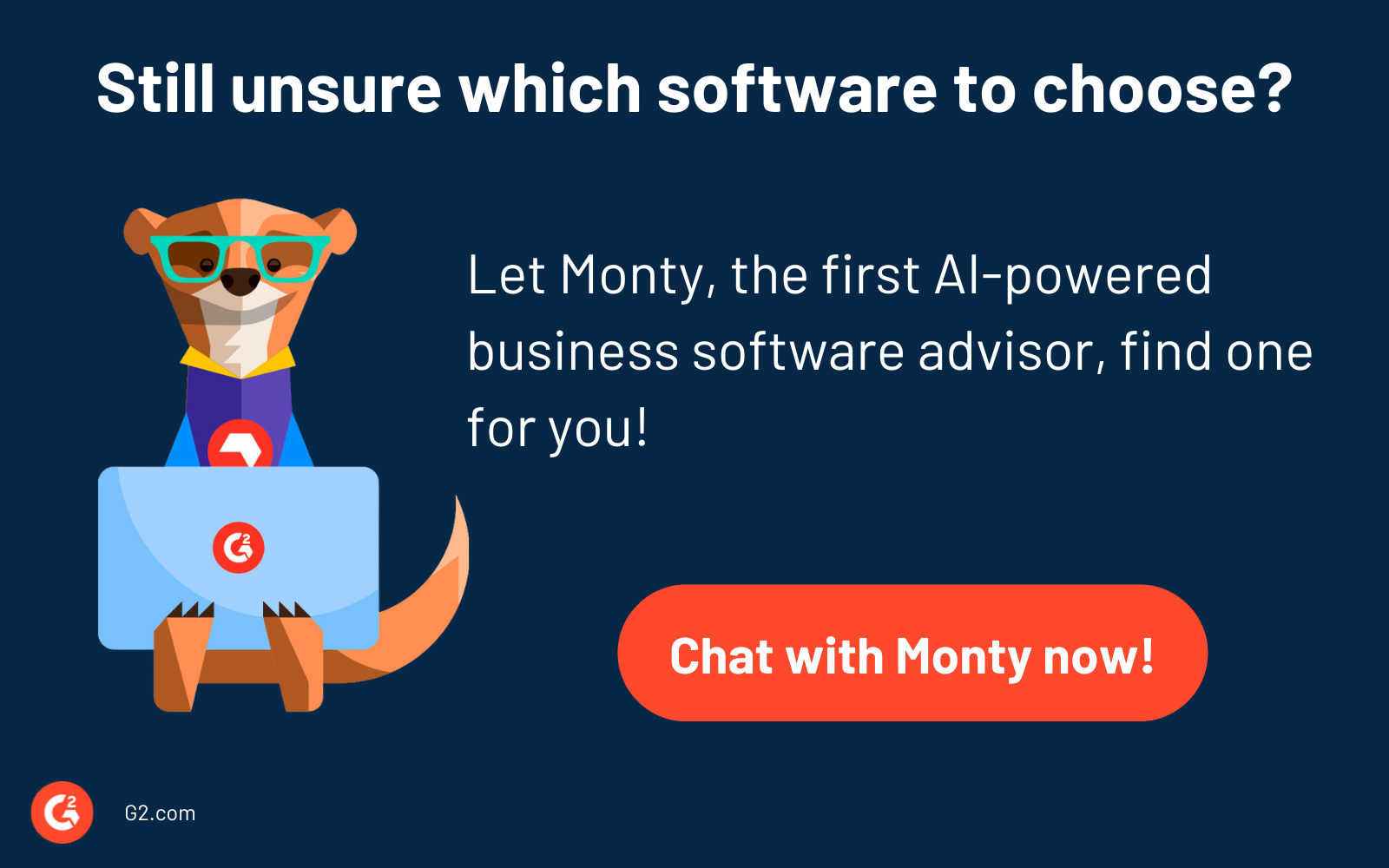
Program management FAQs
Got more questions? We've got you covered. In this section, we'll cover some of the most commonly asked questions about program management and the related fields.
Q: What is the difference between program management and a program management office (PgMO)?
A: Program management is a strategic approach to managing a group of related projects to achieve a common goal. A program management office (PgMO) is a centralized unit within an organization that supports programs and program managers.
PgMO is sometimes called PMO, which is not the correct abbreviation. PMO stands for project management office, a dedicated group that defines project management standards for an organization.
Q: How does project portfolio management (PPM) differ from program management?
A: Project portfolio management manages a collection of projects and programs to ensure they align with the organization's strategic goals. PPM helps identify gaps in the current project portfolio or projects that may hamper the broader organizational initiatives.
On the other hand, program management focuses on managing a group of related projects, known as a program to fulfill relatively shorter-term objectives.
Q: What distinguishes a project manager from a program manager?
A: A project manager manages individual projects, while a program manager oversees multiple related projects within a program to achieve broader strategic goals.
Q: What are the key elements of program management?
A: Key elements of program management include strategic alignment, stakeholder engagement, program governance, resource management, risk management, and benefits realization.
Q: What are the steps involved in program management?
A: Program management typically involves stages such as program initiation, planning, execution, monitoring and control, and closure. These stages ensure systematic management and successful delivery of program objectives.
Leap into profitability, one program at a time
Program management is not just about managing projects. It is about managing people, resources, and risks. It is about delivering results on time and within budget. It is also about making a difference.
Program managers play a crucial role in overseeing and delivering successful programs. Invest time exploring tools like program management software that fits your needs to maximize success and drive excellence in your programs. It's also important to be patient and persistent and to learn from mistakes. If you're willing to put in the work, achieving your organizational goals is guaranteed.
Ready to track the success of your program? Objective and key results (OKR) software helps align program objectives, track key results, and monitor progress toward your goals.

Harshita Tewari
Harshita is a Content Marketing Specialist at G2. She holds a Master’s degree in Biotechnology and has worked in the sales and marketing sector for food tech and travel startups. Currently, she specializes in writing content for the ERP persona, covering topics like energy management, IP management, process ERP, and vendor management. In her free time, she can be found snuggled up with her pets, writing poetry, or in the middle of a Netflix binge.
